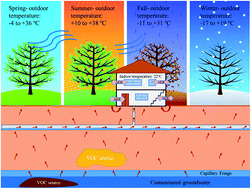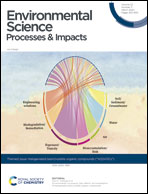Comparison of modeled and measured indoor air trichloroethene (TCE) concentrations at a vapor intrusion site: influence of wind, temperature, and building characteristics†
Abstract
There is a lack of vapor intrusion (VI) models that reliably account for weather conditions and building characteristics, especially at sites where active alternative pathways, such as sewer connections and other preferential pathways, are present. Here, a method is presented to incorporate freely-available models, CONTAM, and CFD0, to estimate site-specific building air exchange rates (AERs) and indoor air contaminant concentrations by accounting for weather conditions and building characteristics at a well-known VI site with a land drain preferential pathway. To account for uncertainty in model input parameters that influence indoor air chlorinated volatile organic compound (CVOC) concentration variability, this research incorporated Monte Carlo simulations and compared model results with retrospective field data collected over approximately 1.5 years from the study site. The results of this research show that mass entry rates for TCE are likely influenced by indoor air pressures that can be modeled as a function of weather conditions (over seasons) and building characteristics. In addition, the results suggest that temporal variability in indoor air TCE concentrations is greatest (modeled and measured) due to the existence of a land drain, which acts as a preferential pathway, from the subsurface to the granular fill beneath the floor slab. The field data and modeling results are in good agreement and provide a rare comparison of field data and modeling results for a VI site. The modeling approach presented here offers a useful tool for decision makers and VI practitioners as they assess these complex and variable processes that have not been incorporated within other VI models.

- This article is part of the themed collection: Halogenated (semi)volatile organic compounds (“X(S)VOCs”)


 Please wait while we load your content...
Please wait while we load your content...